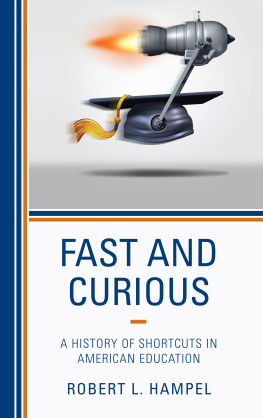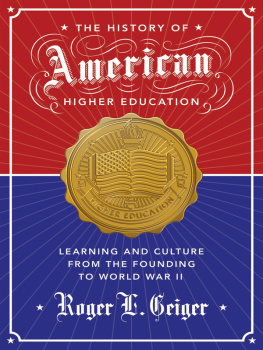Fast and Curious
Fast and Curious
A History of Shortcuts in
American Education
Robert L. Hampel
ROWMAN & LITTLEFIELD
Lanham Boulder New York London
Published by Rowman & Littlefield
A wholly owned subsidiary of The Rowman & Littlefield Publishing Group, Inc.
4501 Forbes Boulevard, Suite 200, Lanham, Maryland 20706
www.rowman.com
Unit A, Whitacre Mews, 26-34 Stannary Street, London SE11 4AB
Copyright 2017 by Robert L. Hampel
All rights reserved. No part of this book may be reproduced in any form or by any electronic or mechanical means, including information storage and retrieval systems, without written permission from the publisher, except by a reviewer who may quote passages in a review.
British Library Cataloguing in Publication Information Available
Library of Congress Cataloging-in-Publication Data
Names: Hampel, Robert L., author.
Title: Fast and curious : a history of shortcuts in American education / Robert L. Hampel.
Description: Lanham, Maryland : Rowman & Littlefield, 2018. | Includes bibliographical references and index.
Identifiers: LCCN 2017032035 (print) | LCCN 2017046154 (ebook) | ISBN 9781475836943 (electronic) | ISBN 9781475836929 (cloth : alk. paper) | ISBN 9781475836936 (pbk. : alk. paper)
Subjects: LCSH: EducationExperimental methodsUnited StatesHistory. | Educational changeUnited StatesHistory. | Educational innovationsUnited StatesHistory.
Classification: LCC LB1027.3 (ebook) | LCC LB1027.3 .H363 2018 (print) | DDC 370.973dc23
LC record available at https://lccn.loc.gov/2017032035
 TM The paper used in this publication meets the minimum requirements of American National Standard for Information Sciences Permanence of Paper for Printed Library Materials, ANSI/NISO Z39.48-1992.
TM The paper used in this publication meets the minimum requirements of American National Standard for Information Sciences Permanence of Paper for Printed Library Materials, ANSI/NISO Z39.48-1992.
Printed in the United States of America
For my first mentors,
historians Michael F. Holt and Joel H. Silbey
* * *
Before the gates of excellence the high gods have placed sweat; long is the road thereto, and rough and steep at first. But when the heights are reached, then there is ease, though grievously hard in the winning.Hesiod
Foreword
In writing this book, Bob Hampel has accomplished a feat that I would have thought impossible. He has produced a wonderfully entertaining account of efforts by a series of entrepreneurs and scam artistsoperating at the fringe of the massive American system of educationwho tried to create quirky shortcuts for the laborious process of learning, and he has done so in a way that provides rich insight into the dynamics at the very core of this system. It turns out that the view from the periphery is remarkably revealing.
The cases he has assembled here run the gamut from correspondence schools and painting by numbers to speed-reading and shorthand and from the Harvard Five Foot Shelf and Classic Comics to abbreviated spelling and Trump University. But all of these widely divergent enterprises are responses to a single impulse: there must be a shortcut to learning, a way to work around the enormous time and effort required by traditional modes of education.
For this reason, the story Hampel tells is distinctively American. Where else in the world would so many people be looking so hard to find an easy way out of the learning process? This impulse has deep roots in the American psyche and has found broad expression in the American educational system. The reason for this is that were a very practical people, more interested in making a living than in intellectual exploration. Toward this end, education is a means to an end rather than an end in itself. Its a necessary evil for everyone who wants to gain the social and economic benefits that schooling can provide: a good job, a reasonable income, and membership in the comfortable classes.
For that reason, we see education as a good investment. Its worth spending all of the time and money and effort required to get the credentials that will in turn open doors for opportunity and the good life. But wouldnt it be nice if there were an easier way to accomplish the same end? Why does it have to be so much work? Why do you have to spend 12 years in school and another four years or more in college, continually deferring your earning years long into the future while also accumulating debt? Wouldnt it be great if you could avoid suffering the endless series of teacher talk and assignments and tests and homework exercises that keep you from enjoying your time as a child and young adult? Wouldnt it be great if you could save yourself and your children from school-induced afflictions such as bullies, math anxiety, please-dont-call-on-me syndrome, writers cramp, mean girls, burnouts, 11:15 lunch, and the inevitable paper cuts?
Americans tend to approach education the same way they approach buying a car. We want the most we can get for the money. We want the shiny car with all the bells and whistles, but we refuse to pay the full sticker price. Thats for saps and suckers. Bargaining for a better deal is something that students learn early in their school careers. They learn to study strategically, focusing on the stuff that is most likely to be on the test and skipping the rest. They develop a canny ability to read the teacher, which then can save them from having to read the book. They focus their attention on the stuff about school that really mattersaccumulating the grades and credits and degrees that can confer on them the extrinsic rewards the system has to offer. So shortcuts are built into American schooling.
This American preference for gaining the rewards of schooling without necessarily accumulating the learning that schools offer helps explain the wide array of efforts that various entrepreneurs have made to develop educational shortcuts. But it doesnt help explain why these efforts, for the most part, failed. If there was ever a promising market for shortcuts to learning, it would be the United States. Nearly all of the initiatives that Hampel presents in this book found a responsive audience and showed some of the elements of success. Harvard Classics and Cliffs Notes and Evelyn Woods speed-reading classes and Famous Artists Schools found large numbers of customers who were willing to pay the freight.
The problem they faced was less a matter of willing customers than a matter of educational legitimacy. Educational credentials pay off only if everyone is willing to accept them as a proxy for learning. They need at least a modicum of credibility. And most of these efforts were hard to defend as serious educational enterprises. Cliffs Notes targeted like a laser on helping students pass the test without actually reading the book. The Famous Artists and Writers schools were hard pressed to demonstrate that anyone who took their courses would ever become a credible, much less famous, artist or writer. Correspondence schools, even the ones run by real universities, had trouble demonstrating that they were comparable to university courses taken for credit. You can read your way through the Harvard Classics, but that doesnt give you the equivalent of a bachelors degree. You may be able to speed-read your way through the Bible in a single sitting, but its hard to demonstrate that you really learned much from this process.
The problem that all of these enterprises confronted was the central premise of American higher education: universities give away knowledge, but they sell degrees. You can pick up all of the knowledge that university faculty generated by reading their publications, which are freely available at public libraries. However, if you want to attain formal certification that you have mastered this information, you will need to matriculate and pay to get a university degree.
Next page









 TM The paper used in this publication meets the minimum requirements of American National Standard for Information Sciences Permanence of Paper for Printed Library Materials, ANSI/NISO Z39.48-1992.
TM The paper used in this publication meets the minimum requirements of American National Standard for Information Sciences Permanence of Paper for Printed Library Materials, ANSI/NISO Z39.48-1992.